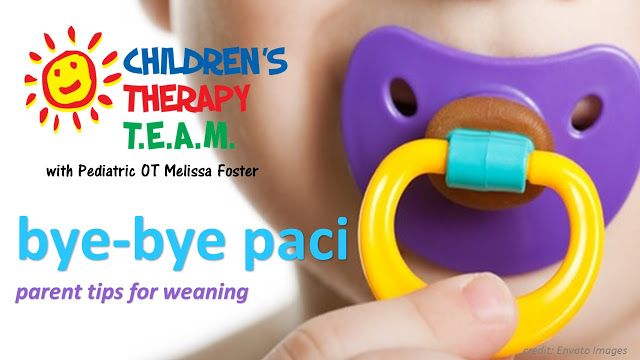My daughter is about to have her first birthday, and we want to start weaning her from the pacifier. Any tips?
I too started weaning both my children from the pacifier around 1 year of age. And, in my experience, the final step of eliminating the pacifier completely at 2 years of age was one of the hardest things I have done as a parent!
Again, a pacifier is a strong source of comfort for many infants/toddlers. And for children with Autism and/or Sensory Processing Disorders, letting go of this consistent source of self-soothing can be particularly difficult. Why exactly do we feel it is necessary to take something away that our little ones so dearly love? Well, nobody ever said parenting was easy. We are the adults. We know that pacifier use shouldn’t last forever. As I have discussed in several recent blog posts, extended pacifier use can hamper speech development, social development, as well as dental/oral structure.
Again, this is HARD. There are many tricks you can try to help the weaning process along, but ultimately a child should be weaned from pacifier use by 2-3 years of age to prevent long term complications/delays. What trick(s) you try vary widely depending on the age of the child. Here are a few of my favorites:
Wean early
If you stop the pacifier “cold turkey” before 6 months of age, the baby hasn’t really developed the chance to voice a strong opinion in the matter. Yes, there will likely be a few days of crying as she learns a different method of self soothing, and you will likely find her wanting to nurse or drink from a bottle more frequently during this time. However, many parents swear that this “cold turkey” method is way easier in infancy than waiting until she has grown into an opinionated toddler.
Wean gradually
I personally used this approach. You slowly disallow the pacifier in more and more environments until you are only left with the night-time pacifier (which is hard to give up!). You might start with “no paci at daycare”, then “no paci while playing”, etc. In my house, we worked pretty quickly to the pacifier only being allowed in the car seat and crib. This makes bedtime and car rides much more enticing, but it is also very hard to wean the pacifier away from these times when soothing is so needed!
Make it less desirable
This method works so well that the people at the One Step Ahead store have even created a product to mimic it. But, let me save you $29.95 plus S&H! For this method, you take away all of the pacifiers in the environment except for 2-3. The child can have these pacifiers any time she wants. BUT, you begin to very gradually cut off the tips of these pacifiers, millimeter by millimeter, at whatever pace you choose, until the child is only left with the hard plastic part, and nothing left to chew on. (Warning: Make sure that the remaining plastic part is not a choking hazard). As the rubbery nipple gets smaller and smaller, the child will loose interest, and no longer ask for it. Problem solved, no tears!
Give it away
This method is more appropriate for an older child. The child must be old enough to understand cause and effect and be able to participate in simple storytelling. Often this occurs around 2-3 years of age. For this technique, you discuss with the child that she is getting older and is now a “big kid”. As part of the story, she can either give the pacifier away (such as to the baby classroom at daycare), or she can leave it for the “Paci Fairy”. Better yet, choose to do this around Christmas/Easter and have Santa or the Easter Bunny do their magic. Whatever story you choose, the magical entity takes pacifiers to babies, and your now “big kid” kiddo may enjoy a new “big kid” toy from the Paci Fairy or Easter Bunny. But here is the kicker. Once you make this exchange, YOU CANNOT GO BACK TO THE PACIFIER! If you turn back now, your child will know that they can make you change your mind any other time in the future that you try to set a firm limit. Not a fun situation to get into with a toddler! Another disclaimer with this technique is that you do not want to give the pacifier away to a close cousin or a new sibling. This can just create jealousy and resentment toward the new baby in her life.
A word of caution
Pacifiers are soothing. And again, they are particularly soothing for children with Autism or Sensory Processing Disorders. If you take away something that is soothing from your child, she will generally find her own replacement item/activity that is self-soothing. Sometimes what your child uses as the new self-soother is even worse than the pacifier! This is a whole different problem on how to fix inappropriate oral sensory seeking. For tips on this, see myprevious blog on this issue.
Do you have a question you would like me to address or ideas about pacifier weaning?
Don’t hesitate to share!
share@childrenstherapyteam.com
Resources:
Ask Dr. Sears: Weaning Off Pacifier, Parenting.com, accessed July 2015
Are Pacifiers OK…A Dentist’s Take, Monday’s with Melissa Blog, Children’s Therapy TEAM, posted June 15, 2015
Night Time Pacifier Use, Monday’s with Melissa Blog, Children’s Therapy TEAM, posted July 6, 2015
Oral Sensory Seeking Help, Monday’s with Melissa Blog, Children’s Therapy TEAM, posted September 15, 2014
Pacifiers: In or Out?, WebMD, accessed July 2015
Pacifier Mistakes, Monday’s with Melissa Blog, Children’s Therapy TEAM, posted June 29, 2015
Pacifier Time vs. Language Development, Monday’s with Melissa Blog, Children’s Therapy TEAM, posted June 22, 2015
10 ways to help your child give up the pacifier, Babycenter.com, accessed July 2015

